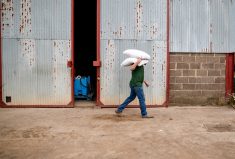It’s no secret — finding employees to work on the farm isn’t getting any easier. Rural populations are dwindling, fewer have skills or aptitudes for farm work, or even any interest in finding out about jobs in agriculture.
But a new initiative announced in late January could potentially send experienced farm managers, equipment operators, meat cutters and a range of labourers to Canada from other countries.
Why it matters: Agriculture faces a critical labour shortage and will need workers to meet its growth potential.
Read Also

Reaction rolls in on Health Canada dicamba restriction proposal
Spray expert says proposed dicamba rule change would ban ‘over the top’ use of the herbicide
The federal government has announced a five-year pilot program, aimed at both attracting and retaining skilled immigrants specifically to Canada’s rural and northern communities.
The new Rural and Northern Immigration Pilot Program will match immigrants to jobs available in select provinces and territories, and work with communities to help them offer supports needed for their settlement.
“By creating an immigration pilot aimed at rural and northern communities, we’re looking to ensure that the benefits of immigration are shared across the country,” said Minister of Immigration, Refugees and Citizenship Ahmed Hussen in a release January 24.
The announcement earned praise from the Canadian Federation of Agriculture (CFA). Their organization sees potential with this to begin to tackle the issue of few skilled immigrants choosing to come to work and live outside Canada’s largest urban centres, said CFA president Ron Bonnett.
This looks to be what the CFA has been looking for, for some time — a way to match people to job vacancies in agriculture and ultimately allow them to remain in Canada and become citizens, he said.
“It’s what we’ve been talking about since 2014, which is creating a pathway to citizenship,” he said.
That year the Canadian Agricultural Human Resource Council (CAHRC) reported 59,000 job vacancies in primary agriculture alone, a number expected to double by 2025.
Meanwhile, agriculture has since been identified by the federal government as a key driver for economic growth. But the industry can’t do it alone, and needs access to more workers.
Bonnett is confident the labour needs of agriculture will be a high priority in this program.
This program has potential to pair people who would want to come to live, work and make rural Canada their home, with the jobs available, he said.
Those are jobs spanning a wide range of skill sets and opportunities in both primary agriculture and processing.
This program will be a first of its kind for Canada, and it will start with employers highlighting their labour needs, and working with local communities.
“Our goal would be to see agricultural employers work with leaders in their community to take advantage of this opportunity to address the permanent, year-round vacancies they face on a long-term basis, while contributing to the vibrancy and prosperity of rural Canada, which continues to evolve alongside their businesses,” said Bonnett.
Farm organizations will have a supporting role to play, he added.
“Individual farmers will likely find it to be a bit of a landmine to walk through all the details, but there’s an opportunity for farm organizations themselves to get involved,” he said.
“They will need to work with employers and leaders in their community, and put forward a compelling case that lays out their long-term needs, the settlement services they can provide and the overall quality of life they, as a community, can provide.”
Bonnett said he doesn’t foresee agricultural sectors competing for these workers. The labour shortage is right across the board.
“Generally speaking, farm manager and farm labourer are the two largest vacancies, but those terms catch a lot of diversity,” he said. “I don’t view it as a competition between sectors, but a chance for all employers in those regions to potentially benefit.
It will be important to remember this is also a pilot program and there are things to learn from it.
“I’m not going to say this is going to solve all the problems,” he said.
“But what we really hope for is we’re going to get some initiatives off the ground quickly, that show how it can work and that can then be something that can be replicated in other areas. I think what we need now is quick success stories to show that it can work.”
Timelines are tight to participate. Communities eligible to apply must submit a ‘Community Interest’ form and necessary documents before March 1.
Applications must have the support of local municipalities. Local or regional organizations that support immigrants and economic development organizations are expected to play a key role. Communities selected to participate must show preparedness to welcome newcomers, and have capacity to connect them to available settlement services.
More information about the program is found at the Government of Canada website.
















